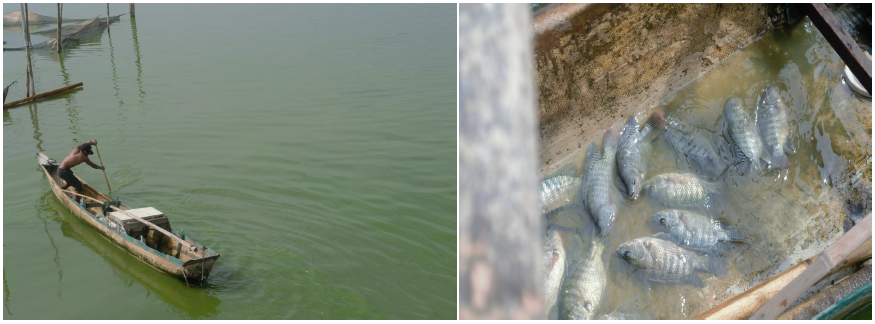
(JUN. 13)—LAGUNA, Philippines – Thousands of dead tilapia and bangus were scattered in the fishing zone of Laguna de Bay as a massive fish kill incident occurred in Biñan and Pila Laguna.
Vernan Magundayao, a resident and a fisherman at Biñan said an estimated 500,000 fish have died inside the fish cages while most of the remaining ones are producing foul odor considering it as non-marketable. He added that the said fish kill started on May 4 and lasted until the end of May.
Roy San Juan, a fisherman at Barangay Linga, Pila Laguna, said the fish kill in his area started on Sunday, May 12, killing 60 percent of tilapia and 80 percent of bangus in the cages. San Juan said the fish kill will end once the rainy season comes.
Ireneo G. Bongco, Senior Science Research Specialist at Laguna Lake Development Authority (LLDA) said the fish kill was caused by green tide (red tide in saltwater) or algal blooms, where the fish suffered from asphyxia due to deficiency in dissolved oxygen (DO) level concentration brought by the competing thick layer of green tide in the lake surface.
“Although mataas yung level ng oxygen dahil marami yung algal bloom dahil sa maaraw na panahon, sa gabi naman, ginagamit ng algae yung naproduce niyang oxygen for respiration so nagkakaroon ng reverse process. Since kailangan din ng isda yung oxygen, nagkakaroon ng competition, ginagamit ng algae yung oxygen and at the same time nung isda, kaya ang nangyayari, since makapal yung algal bloom at mas maraming oxygen na kailangan for respiration, yung oxygen na kailangan ng isda nagkukulang, yun ang ikinamamatay ng isda.
(Although there is a high level of oxygen produced by the algal bloom due to dry spell, during night, the algae use the oxygen for respiration so there is a reverse process. Since the oxygen is needed by fish as well, competition happens. The algae use the oxygen as well as the fish but because of the algal bloom, there is much oxygen needed by the algae resulting to lack of oxygen for the fish, and that is the reason why the fish dies),” Bongco stated.

Algal bloom usually known as “red tide” in saltwater and “green tide” in freshwater is the rapid enrichment of green algae (liya) in an aquatic system which happens when water temperature is warmer than usual. Higher concentration of nutrients in water particularly Ammonium (NH4–), and Phosphate (PO43-) compounds cause increase growth of algae resulting to algal bloom. “Actually, naturally present na siya (liya) diyan sa environment kaya lang nati-trigger siya ng environmental condition,” explains Bonco.
Researchers from the UP Institute of Environmental Science and Meteorology (UP-IESM) Environmental Pollution Studies Laboratory (EPSL), together with LLDA, conducted the water quality monitoring on May 29 as part of their deliverable to the Program SCALE, (Synergistic Capacity Advancement in the Management of Laguna LakE). Based on initial findings from the water quality test report of EPSL, DO from the area of Biñan is lower than the standard limit of the Department of Environment and Natural Resources Administrative Order 2016-08 (DAO 2016-08) and ammonium and phosphate nutrients are found higher than the prescribed limits. (Refer to Table 1)
Table 1. Result of the water quality test conducted on May 29 at the area of Biñan, Laguna.
| PARAMETERS | FINDINGS | DAO 2016-08 | RESULT |
| Dissolved Oxygen | 4.7 mg/L | 5.O mg/L | Non-compliant with the limits |
| Ammonia | 0.16 mg/L | 0.05 mg/L | Non-compliant with the limits |
| Nitrate | 0.4 mg/L | 7.0 mg/L | Within Limits Lower |
| Phosphate | 1.00 mg/L | 0.5 mg/L | Non-compliant with the limits |
Program SCALE aims to address the impacts of watershed disruption, ecological land degradation and aquaculture pollution by identifying the emerging water contaminants, tracking the sources of microbiological pollutants and quantifying the extent of contamination in commodity fish in Laguna de Bay. Funded by the Department of Science and Technology, and in collaboration with the LLDA, the program is implemented by UP Diliman College of Science Institute of Environmental Science and Meteorology, Institute of Chemistry, and Natural Sciences Research Institute.—Liza Jane Angeles
